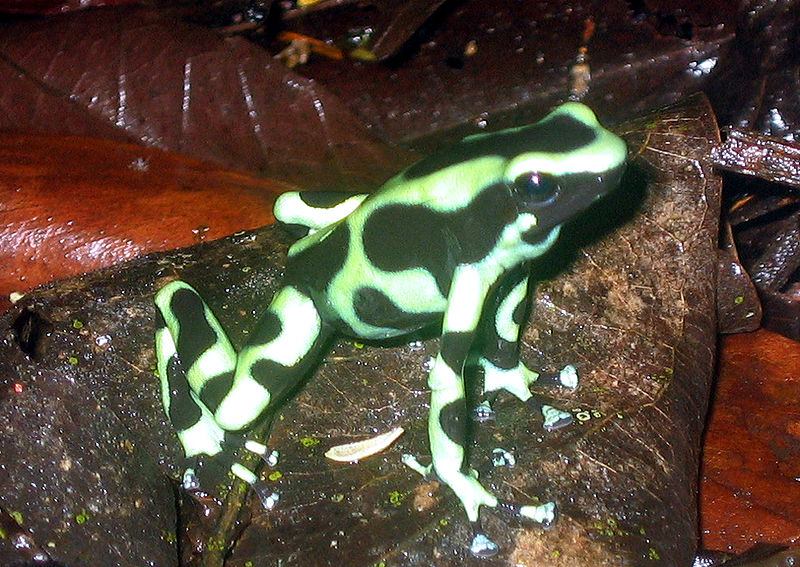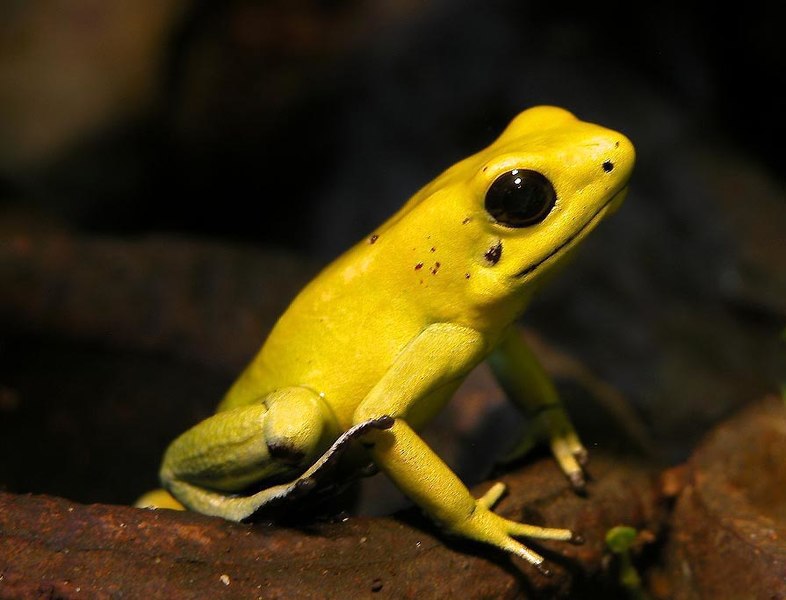
To read the first part of this article, click here.
General
This and other poison frogs are among the most interesting amphibians of all to keep in the terrarium. They are colorful, active by day and quite willing to display a wide range of complex and fascinating behaviors when kept properly. No other group of amphibians exhibits such a variety of social interactions that can be so easily observed in captivity.
Please note that the blue poison frog has been re-classified as a color phase of the dyeing poison frog, D. tinctorius, and is no longer considered to be a distinct species. I have retained the scientific name D. azureus in the title as it is still commonly used in the pet trade.
Space and Other Physical Requirements
Blue poison frogs do best in a terrarium heavily planted with ferns, moss and moisture-loving plants such as Philodendron, Epipremnun and Pothos. Rather than hiding the frogs from view, a densely planted tank will actually provide you with more opportunities for interesting observations, as the frogs will feel secure and will behave normally. In barren terrariums, they become stressed and remain inactive.
Live plants also assist in breaking down waste products. If you pay close attention to small details such as spot-cleaning, you may be able to maintain your terrarium more or less unchanged for quite long periods of time – several of my own have not had a substrate change in 10-12 years (note: these are heavily planted and lightly stocked with frogs). Small land snails and isopods (sow bugs) are valuable scavengers and go a long way in maintaining terrarium cleanliness. Poison frogs are very aware of their environments, and do best when left undisturbed by major terrarium renovations.
The substrate should hold moisture and support plant growth. A mix of Jungle Earth Reptile Bedding, Coconut Husk and peat moss, with a bit of topsoil mixed in, works well. A layer of gravel at the bottom of the tank will assist with drainage. Sheet moss or Compressed Frog Moss should cover the substrate to help retain moisture.
A screen cover secured by clips should be used – despite being terrestrial, poison frogs climb well and will escape through even the tiniest of openings.
In addition to standard aquariums, these frogs may also be kept in Exo terra glass terrariums and similar enclosures.
Poison frogs do not swim well, and drown quickly in deep water. De-chlorinated water of ½ inch or so in depth should provided in shallow bowls or a small, sloping pool can be created in one corner of the terrarium. The pool can be cleaned by sopping up the water with paper towels or, if large enough, may be filtered with a sponge filter.
Despite their small size, poison frogs need quite a bit of room – more so, and with many visual barriers (plants, logs, etc.), in a group situation. A pair or trio can be kept in a 10 gallon aquarium, or up to 10 in a 55 gallon tank.
Light, Heat and Humidity
Although diurnal, poison frogs do not require high levels of UVB — in fact, their skin is equipped with a UVB “filter” of sorts. However, live plants do best with full spectrum lighting. Therefore, the terrarium should be lit by a low-UVB output fluorescent bulb, such as the Reptisun 2.0. In my experience, this bulb provides enough light for most plants, and yet does not lead to the cataract and other problems seen in amphibians that are exposed to high UVB output bulbs.
Humidity should be high at all times (80-100%), but fresh air flow is essential. Therefore, you should not increase the humidity level by covering a portion of the screen top with plastic. Keeping the sheet moss layer damp and spraying the terrarium heavily in the morning and evening should suffice. If your home is unusually dry, consider installing a small mister.
Daytime temperatures in the terrarium should range from 75-82 F (a heavy cover of plants in one area will provide shade and a cooler area for the frogs) and can dip to 73 F at night. A fluorescent light may provide enough heat – if not, install a 25 watt incandescent bulb but be sure to monitor the temperature and watch that the tank does not become too dry.
Feeding
Proper feeding is the key to maintaining poison frogs long-term in captivity. In the wild, they feed on a wide variety of invertebrates. Unfortunately, the tiny size of these frogs makes it difficult for us to provide them a varied diet, and too often they are forced to subsist on only one or two items. Please remember that crickets supplemented with vitamins do not provide an adequate diet, and strive to include as many of the following as possible to your frogs:
Flightless fruit flies – cultures are available commercially; these can comprise up to 50% of the diet.
Pinhead and 10 day old crickets – these are poison frog standards, but should not be used exclusively. Be sure to feed the crickets for 2- 3 days with commercial cricket food, flake fish food, oranges and other fruits before feeding them to your frogs.
Springtails – cultures available commercially, or these tiny insects can be gathered below leaf litter, along with small millipedes. These are particularly useful when raising young frogs.
Termites – an absolute favorite, and one of the most valuable food items of all. Collect termites in dead logs. Termites love to eat cardboard – damp pieces placed below a board near a colony will attract hoards (I’ll provide info on a trap you can make in a future article). Escaped termites (other than a queen!) will not establish a colony in your home.
Flour beetle larvae – I was introduced to these by poison frog expert Bob Holland, who had frogs living into their late teens long before zoos here were able to do so. Flour beetles can often be found in old boxes of cereal or dog biscuits, or can be purchased from biological supply houses.
Ants – you’ll need to experiment here, as some species are unpalatable, but it is worth the effort. Keep your eyes open for mating flights, when thousands can be collected. Do not leave large numbers of ants in the terrarium.
Aphids – these tiny insects may be found on plant stems. Clip the stem and place it in the terrarium, or shake the insects over the tank – your frogs’ reactions will leave no doubt as to their appreciation of your efforts!
Wild caught insects – light traps such as the Zoo Med Bug Napper will provide tiny flies, gnats, moths and midges.
“Field Plankton” – this is the term for insects gathered by sweeping tall grass with a net. Of course you will need to exclude large and dangerous insects and spiders. One way to do this is to place the contents of the net in a plastic container perforated with tiny holes, so that only the smallest insects can escape into the terrarium.
Blue poison frogs should be fed every day or two. They have quite large appetites and, in contrast to other frogs, rarely become obese in captivity. Their condition should be monitored closely – thin animals will exhibit protruding hip bones and flat stomachs. This is especially important in group situations, where dominant animals might prevent others from feeding properly.
The food given to growing frogs should be powdered with a vitamin/mineral supplement at every other feeding, or at every feeding if their diet is not varied. Adults do best when supplemented twice weekly.
Captive Longevity
Captive longevity approaches 15 years.
Enrichment
There are a great many techniques that can be used to enrich the lives of your pets. I’ll address several of these in a short note next week.
Breeding
Breeding poison frogs is a fascinating endeavor. These and related species have quite complicated reproductive behaviors, and exhibit a high level of parental care to their eggs and tadpoles. I will address this topic in a future article.
An article with natural history details and information on the care of blue dart frogs in zoos is posted at:http://www.waza.org/virtualzoo/factsheet.php?id=403-004-002-004&view=Amphibia&main=virtualzoo
 Poison Frogs (also known as Dart or Arrow Poison Frogs) exhibit an amazing array of colors and patterns – some so spectacular as to appear unreal. What’s more, they are active by day, exhibit complex social behaviors, and care for their tadpoles in “mammal-like” fashion…and are not at all shy about doing so. Small wonder they are among the most desirable of all amphibian pets! Once considered delicate captives, Poison Frogs are now regularly bred in captivity and may live to age 15 or beyond.
Poison Frogs (also known as Dart or Arrow Poison Frogs) exhibit an amazing array of colors and patterns – some so spectacular as to appear unreal. What’s more, they are active by day, exhibit complex social behaviors, and care for their tadpoles in “mammal-like” fashion…and are not at all shy about doing so. Small wonder they are among the most desirable of all amphibian pets! Once considered delicate captives, Poison Frogs are now regularly bred in captivity and may live to age 15 or beyond. That Reptile Blog – Reptile, Amphibian and Exotic Pet Care and Information
That Reptile Blog – Reptile, Amphibian and Exotic Pet Care and Information


 The skin secretions of only 3 species of frog have been identified as being used as dart coatings. These frogs are not, as often believed, the familiar Dendrobates species, but rather belong to the related genus Phyllobates. Frogs belonging to this genus are less commonly seen in the pet trade than Dendrobates, although one, the Golden Poison Frog (P. terribilis), is fairly well-established in captivity.
The skin secretions of only 3 species of frog have been identified as being used as dart coatings. These frogs are not, as often believed, the familiar Dendrobates species, but rather belong to the related genus Phyllobates. Frogs belonging to this genus are less commonly seen in the pet trade than Dendrobates, although one, the Golden Poison Frog (P. terribilis), is fairly well-established in captivity.
